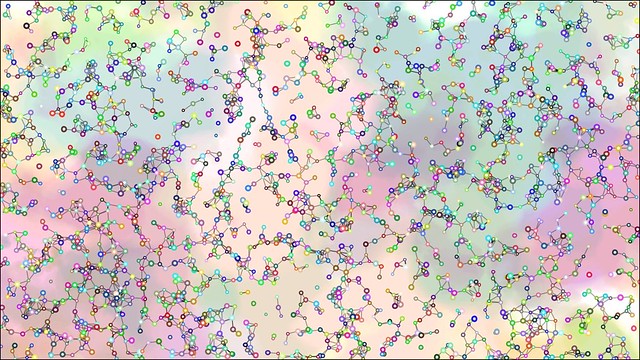Random graphs and networks
The world-wide web is just one modern example of the enormous networks that we encounter in our everyday lives. Probabilistic models help us to understand how the fascinating properties of these networks emerge.
Cécile Mailler, Marcel Ortgiese, Mathew Penrose, Tim Rogers and Matt Roberts are all interested in random graphs and networks.
Interacting particle systems
Who will you vote for? Your decision is probably affected by the opinions of the people around you. In a similar way, many natural phenomena involve systems of particles that interact in complex ways. Mathematical models of interacting particle systems often arise from physics, biology and chemistry.
Members of Prob-L@B who work on these models include Antal Járai, Christoforos Panagiotis and Tim Rogers.
Random walks and Brownian motion
An ant in a labyrinth or a particle of pollen in a jar of water: random walks and Brownian motion have been at the very centre of probability theory for many years. Besides being interesting processes in their own right, they are also fundamental to the study of many of the other topics on this page.
Members of Prob-L@B who study Brownian motion and random walks include Alex Cox, Daniel Kious and Cécile Mailler.
Stochastic analysis
Understanding complex stochastic systems often requires us to study equations where the randomness and the evolution of the system are closely linked, to the extent that new mathematical techniques are required to make sense of the solutions. Such systems arise in areas as diverse as mathematical physics and the study of financial markets, and the development of new mathematical tools are often linked to breakthroughs in the understanding of these underlying systems.
Alex Cox works in this area.
Branching structures
Used to model family trees, computer algorithms and the spread of disease, branching processes are also a key tool in studying many other areas of probability. In Prob-L@B we are working with industry to use branching models to improve the safety of nuclear power stations.
Members of Prob-L@B who work with branching structures include Cécile Mailler, Marcel Ortgiese, Sarah Penington and Matt Roberts.
Percolation and stochastic geometry
Imagine water seeping through the rock beneath your feet, or coffee through a filter: what decides whether the liquid will be able to pass through the material? In a similar vein, what are the connectivity properties of random geometric graphs such as the one at the top of this page? Percolation theory and stochastic geometry address these types of question.
Members of Prob-L@B who are interested in stochastic geometry include Antal Járai, Daniel Kious, Christoforos Panagiotis and Mathew Penrose.
Combinatorial probability
Counting and understanding how many structures exist with a particular collection of properties is one of the most creative areas of mathematics, and has many applications, especially to computer science. Probabilistic combinatorics includes the study of random trees, networks and Pólya urns. There are many links with the study of graphs and networks.
Cécile Mailler, Christoforos Panagiotis and Matt Roberts all work in this area.
Self-organized criticality
Many phenomena in nature, such as earthquakes or avalanches, show mathematical order - known as self-similarity - despite their chaotic nature. Self-organized criticality explains why this remarkable incongruity is, in many cases, inevitable.
Antal Járai is an expert on Abelian sandpiles and related models showing self-organized criticality, which he studies mainly through connections with uniform spanning trees and loop-erased random walk. Christoforos Panagiotis is also interested in this subject.
Mathematical finance
Understanding financial markets, including how to price assets and hedge risk, is important for everyone from supermarkets to government officials. Questions that arise from these applications are regularly difficult and lead to interesting mathematics.
Alex Cox has work in this area.
Monte Carlo simulation
Monte Carlo algorithms are designed to solve deterministic problems using randomness. They are used everywhere, from nuclear physics to aerospace engineering. The Department of Mathematical Sciences is also home to a large numerical analysis group, and there is strong interaction between the two groups.
Members of Prob-L@B who work on Markov chain Monte Carlo topics include Alex Cox.
